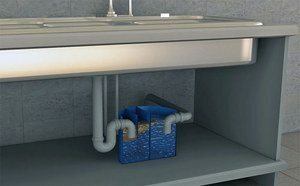 The sewage system in the kitchen is very often clogged. Most often this is due to the fact that fat accumulates on the walls of the pipes. A wide range of chemicals presented in our stores helps for a short time. In "severe" cases, they do not help at all. In this article, we will tell you how to make a household grease catcher for a sink with your own hands.
The sewage system in the kitchen is very often clogged. Most often this is due to the fact that fat accumulates on the walls of the pipes. A wide range of chemicals presented in our stores helps for a short time. In "severe" cases, they do not help at all. In this article, we will tell you how to make a household grease catcher for a sink with your own hands.
For every housewife, not only comfort and beauty in the kitchen is very important, but also flawless disposal of household fat waste in the kitchen. This is one of the main problems of blockage formation. A household grease catcher will help to solve this problem.
Attention! Earned on our website kitchen designer. You can familiarize yourself with it and design your dream kitchen for free! May also come in handy wardrobes designer.
What is it? Grease trap is a special installation that will separate fat from wastewater. It is installed under the kitchen sink and is connected to the sewage system in a special way.
The grease trap is in great demand in cafes, restaurants, canteens, etc. This is required by sanitary standards. However, it is also in great demand at home.
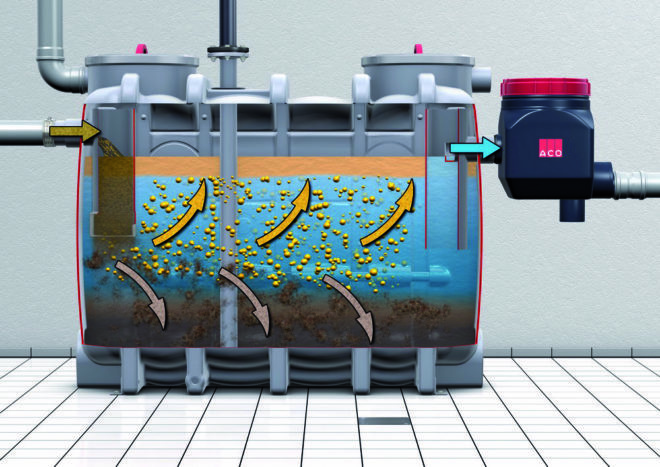
Main tasks
One of the main tasks of a kitchen grease trap is to protect the inside of the sewer pipes from household grease. Over time, the presence of grease in the interior of the pipes contributes to the accumulation of dirt and the occurrence of blockages.
The grease trap for the kitchen also helps to prevent the development of bacteria and unpleasant odors from the drain. In private houses, a household grease trap will help solve the problem of clogging of drainage wells and gutters, it is a simple and easy-to-maintain structure.
If you take good care of household plumbing, it will serve as a reliable assistant for many years.
Requirements
The requirements for a grease trap for the kitchen are quite simple:
- Must separate fat from waste water;
- And reliably protect the sewer pipes from sticking, accumulation of food kitchen waste.
Operating principle
The principle of the kitchen grease trap is based on the difference in the density of water and fat. Food waste from kitchens tends to settle in the wastewater in the lower layers. Fat has a lower density than water, so it always remains on the surface. That is, heavy liquids push the lighter ones up - this is the basis of the principle of the grease trap.
Household grease trap options
A household grease catcher can be purchased at the store. For example, on the Internet there are a large number of online stores selling and installing grease traps for the kitchen. And you can also do it yourself.
Material
For its manufacture, you can use materials such as:
- fiberglass;
- steel;
- polypropylene;
- food grade plastic.
The above material can be used to make the body of the product. You will also need sanitary silicone, building glue, thermoplastic materials with a diameter of 5 cm:
- tee;
- part of the pipe;
- knee.
Most often, plastic or fiberglass is used in the manufacture. These materials are convenient to work with, their useful life is quite long at a low cost.
Determination of dimensions
First of all the performance of the grease trap should be determined. To do this, use the following formula:
- P = n * S, where
- P - productivity (l / s);
- n is the number of washes;
- S is the rate at which water is supplied (usually 0.1 l / s).
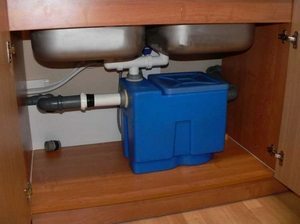 Then the required installation volume should be determined. To do this, you need to use the formula:
Then the required installation volume should be determined. To do this, you need to use the formula:
- V = 60 * P * t, where
- V is the volume;
- P is the above-calculated productivity of the installation;
- t - average value of fatty acid sedimentation (usually 6 min)
Manufacturing
The drawing and video are at the end of the article, but for now let's figure out what it consists of:
- Tank for wastewater sedimentation, consisting of several parts-compartments;
- Tube (flexible, corrugated) that connects the sink to the grease trap;
- Tube (flexible, corrugated) designed to drain water into the sewer;
- Special storage tank for fat;
- Airtight cover required to prevent odor from escaping.
Installation
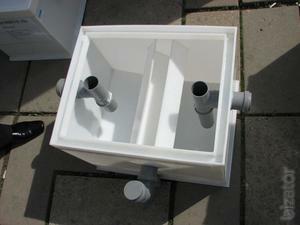 First of all, you need to determine if there is enough space under the sink. As a rule, many household kitchen and other items are stored under it. It is advisable for them to determine a new storage location or dispose of.
First of all, you need to determine if there is enough space under the sink. As a rule, many household kitchen and other items are stored under it. It is advisable for them to determine a new storage location or dispose of.
Almost everyone in the kitchen installs a furniture set, trying to close the sink with a door. For correct operation and the convenience of its subsequent maintenance, when installing the grease trap with your own hands, it is necessary to provide a distance from the wall of at least 2 cm.
The bottom surface of the cabinet unit must be flat and installed without tilting. Otherwise, oils and fat will overflow, and cleaning work will not be possible to carry out efficiently. After completing all the above steps, you can proceed with the installation.
Operating procedure:
- Place the grease trap under the sink;
- Connect the sink to the outlet of the product using flexible pipes (corrugated). Ensure the correct orientation of the grease catcher. It is necessary to make the connection from the side on most of the installation box, since this is where fat will accumulate;
- We connect to the sewer with the same flexible pipes (corrugated).
During installation work, a sealant must be used. This will more reliably secure the docking of the installation and flexible pipes, which will avoid leakage and the release of an unpleasant odor, which will surely be formed.
Service
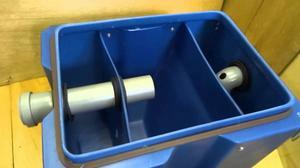 One of the main points in the operation of the grease catcher is maintenance. After some time after installation, it is imperative to clean it. Kitchen and work in the kitchen require a neat attitude and sanitary cleanliness.
One of the main points in the operation of the grease catcher is maintenance. After some time after installation, it is imperative to clean it. Kitchen and work in the kitchen require a neat attitude and sanitary cleanliness.
Grease trap maintenance work begins with the process of cleaning the drive. It must be pulled out, grease and oils thrown into the trash. To determine how often the grease trap needs to be cleaned, it is necessary to carry out these works several days in a row. In the future, the frequency of cleaning the installation will be clear.
Besides, about once every six months it is required to open the grease trap and disinfect. Such work is necessary to prevent harmful bacteria and microorganisms.
Grease catcher drawing
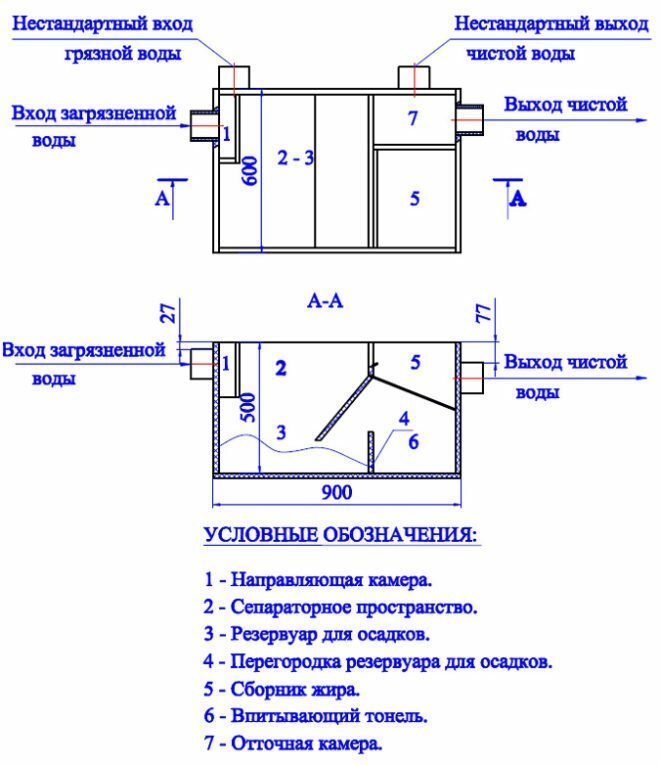
Video: the principle of operation, we make a grease trap for the kitchen sink with our own hands
average rating 0 / 5. Number of ratings: 0
No ratings yet. Be the first to rate.


